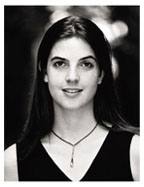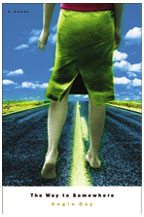March 26, 2003: Reading Room
 Bloopers
by day, fiction by night
Bloopers
by day, fiction by night
Angie Day ’94 publishes first novel
Photo: Angie Day ’94 chronicles the rocky youth of Taylor Jessup in The Way to Somewhere. (Rob Barocci)
Angie Day ’94 wrote a short-story collection, We Do Angels, for her senior thesis, but her creative writing faded after she started her first job, as a financial analyst. “I didn’t think I could be the broke artist right away,” says Day, who majored in English with a certificate in theater and dance.
After 18 months on the job, traveling in Latin America and “developing the right side of my brain,” Day left for a more freewheeling existence in the New York film and TV industry. After doing production work for commercials, films, and the Travel Channel, she freelanced for an MTV blooper show, which led Day, in a roundabout way, back to writing and her first novel, The Way to Somewhere, published by Simon & Schuster last year. Her day job at MTV “dealt with such silly stuff that it was a relief to go home to something more serious. There’s nothing like looking at bloopers all day to reinforce the need to write,” Day recalls.
 Working
“every other night and one day on the weekend,” she cranked
out a draft of the novel in six months. The book chronicles the rocky
but picaresque coming-of-age of Taylor Jessup in working-class Houston.
The book follows Taylor’s tumultuous family life, first loves, adventures
south of the border, serendipitous interest in furniture restoration,
move to New York, and evolving sense of self and family. Day blended her
life experiences growing up in Houston and traveling in Mexico with imagination
and intensive research. An understated sense of faith, specifically Catholicism,
also winds through The Way to Somewhere.
Working
“every other night and one day on the weekend,” she cranked
out a draft of the novel in six months. The book chronicles the rocky
but picaresque coming-of-age of Taylor Jessup in working-class Houston.
The book follows Taylor’s tumultuous family life, first loves, adventures
south of the border, serendipitous interest in furniture restoration,
move to New York, and evolving sense of self and family. Day blended her
life experiences growing up in Houston and traveling in Mexico with imagination
and intensive research. An understated sense of faith, specifically Catholicism,
also winds through The Way to Somewhere.
Publishers Weekly called Day’s novel “The debut of a sharp, concise, and funny writer.” And the New York Times wrote, “In the end, Taylor isn’t entirely transformed, but she is — like the author — definitely getting somewhere.”
Day says she “fell in love with the character” of Taylor, who struggles to find her own definition of happiness. “The character began being successful after disengaging from the American dream and looking inward,” observes Day. The book’s other characters — Taylor’s parents and friends — are drawn with realism and sympathy, as people with foibles but the ability to change.
Unlike Taylor, who eventually leaves New York, Day is content in the city and continues working for MTV by day. She developed and is producing the series MADE, which features individuals, mostly high school students, who are trying to change something about themselves — an overweight “drama geek” who wants to become a cheerleader, for example. By night, Day is writing her second novel. All she’ll say about the story is that it “follows more of a family than just one character.”
And like every good writer, she reads constantly, most recently John
Irving’s autobiography, The Imaginary Girlfriend, and Kate Morgenroth’s
Saved. ![]()
By Van Wallach ’80
Van Wallach is a freelance writer in Connecticut.
Book Shorts
 Art of War: Eyewitness
U.S. Combat Art From the Revolution Through the Twentieth Century —
H. Avery Chenoweth ’50 (Friedman/Fairfax). This book brings together
paintings, drawings, and sketches of armed conflicts around the world
and across three centuries of American history. The selections depict
the hardships of war and are set in historical and biographical contexts.
Chenoweth is a retired Marine Corps officer.
Art of War: Eyewitness
U.S. Combat Art From the Revolution Through the Twentieth Century —
H. Avery Chenoweth ’50 (Friedman/Fairfax). This book brings together
paintings, drawings, and sketches of armed conflicts around the world
and across three centuries of American history. The selections depict
the hardships of war and are set in historical and biographical contexts.
Chenoweth is a retired Marine Corps officer.
 A Magic Web: The Tropical
Forest of Barro Colorado Island — Egbert Giles Leigh Jr. ’62
(Oxford). In this book, studded with colorful photographs by Christian
Ziegler, Leigh explores Panama’s tropical forest and the complex
relationships between its plants and animals. A Magic Web also describes
the importance of tropical forests to the people living near them and
to the world at large. Leigh is a biologist at the Smithsonian Tropical
Research Institute in Panama.
A Magic Web: The Tropical
Forest of Barro Colorado Island — Egbert Giles Leigh Jr. ’62
(Oxford). In this book, studded with colorful photographs by Christian
Ziegler, Leigh explores Panama’s tropical forest and the complex
relationships between its plants and animals. A Magic Web also describes
the importance of tropical forests to the people living near them and
to the world at large. Leigh is a biologist at the Smithsonian Tropical
Research Institute in Panama.
 The Strike That Changed
New York: Blacks, Whites, and the Ocean Hill-Brownsville Crisis —
Jerald E. Podair *97 (Yale). This book looks at the racially charged firings
of 19 white teachers by a predominantly black school board in the Ocean
Hill-Brownsville area of Brooklyn in 1968. The firings prompted three
teachers’ strikes and angry confrontations. Podair explores its continuing
influence on city politics and culture. Podair is an assistant professor
of history at Lawrence University.
The Strike That Changed
New York: Blacks, Whites, and the Ocean Hill-Brownsville Crisis —
Jerald E. Podair *97 (Yale). This book looks at the racially charged firings
of 19 white teachers by a predominantly black school board in the Ocean
Hill-Brownsville area of Brooklyn in 1968. The firings prompted three
teachers’ strikes and angry confrontations. Podair explores its continuing
influence on city politics and culture. Podair is an assistant professor
of history at Lawrence University.
By Jeanne Alnot ’04
